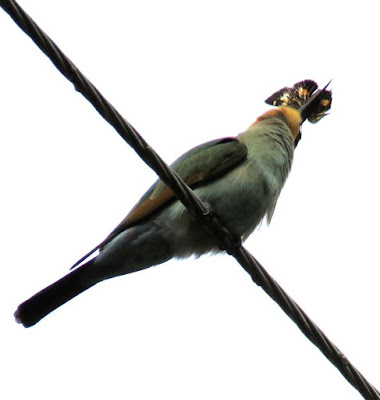A flock of Rainbow Bee-eaters has been in the area and their distinctive twittering calls announce their arrival around the house. Today, late in the afternoon I counted ten individuals on our powerline that provided an ideal perch to swoop on any flying insects.
None of the birds had the long streamer feather of the adult male so I guess they are juveniles and females. I watched them dive after insects and then come back to the wire where they manipulated the prey in a position to swallow. Most took a short time but one came back with a butterfly in its beak and it took a bit of time to get it into the right position, so I managed a couple of photos.
The markings on the butterfly wings indicate a Skipper species and my best guess is
"iacchoides skipper" Trapezites iacchoides although there are a couple of the skippers that are very similar.
Rainbow Bee-eaters really live up to their name and are among the most colourful of birds.




